
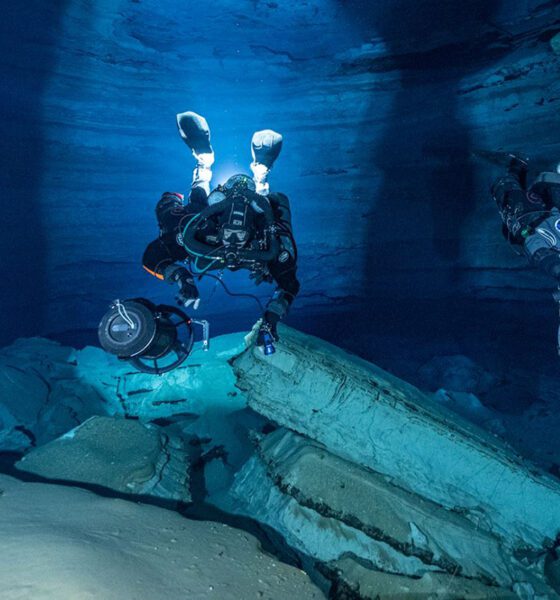
Latest Features
Our Journey Into Bailout Rebreathers
Karst Underwater Research (KUR) exploration divers Bob Beckner, and KUR executive director Matt Vinzant discuss their journey and experience with bailout rebreathers including a discussion of various units, lessons learned, specifics on gas planning and added complexities, and how bailout breathers factor in KUR’s team diving operations. Is there a bailout rebreather in your future?
By Bob Beckner and Matt Vinzant. Images courtesy of Kirill Egorov. Lead image: Bob Beckner (left) with CCR bailout and Gary Donahue (right) about 104m/330 ffw deep with 2km + penetration at an undisclosed location.
This article is the opinion of the authors and does not reflect the views of Karst Underwater Research (KUR). KUR does not dictate configuration or promote any specific manufacturer.
The use of a bailout rebreather (BOB) in technical diving brings a myriad of variables and plenty of fans and critics alike, but for some of us, it fits.
We will discuss our choice of BOB, some lessons learned, its use in a team, and a few thoughts on complexity and gas planning. First, Let’s review who we are, our experience, and our typical diving routines for the last decade.
Matt Vinzant is currently the Executive Director of Karst Underwater Research (KUR), a former TekDive USA Explorer of the Year, and active explorer. He has participated in several Beyond the Sump Projects and the recent Wakulla project with Bill Stone. Bob Beckner brings nothing so glorious to the table, but he has been cave and technical diving since 1997 and has been involved with several expeditions to the USS Monitor, Mote Marine’s Green Banana project, and is passionate about photo documenting Florida’s Caves with Kirill Egorov.
Collectively, we have many hundreds of dives in caves over 3,048 m/10,000 ft one-way linear penetration, sometimes exceeding 122 m/400 ft in depth, durations of 10+ hours and untold time hanging on deco with and without habitats. All this is not to boast, but to provide a background for our experiences without the use of a BOB. These types of dives are how we have assessed BOB utility: its advantages, disadvantages, and the logistical impacts of its use.
Disclaimer: I Hate Homework! To me, detailed dive logging counts as homework. I work diligently to create processes through practice where I can create a firm base of knowledge and experience in use. I then apply the processes for specific types of technical dives in a plug-and-play style of planning. There isn’t enough space to go into much detail on this method but, suffice to say, there is enough historical execution and experience to allow me to apply what bailout and other necessities will be needed for the next dive.
That is not to take away from the value of hard, warehoused data. I just don’t do much of it. Matt is much better at homework than I am and is a tinkerer of the highest order. He works constantly to refine his kit and configuration which I then shamelessly copy. This is important to share as we understand some divers want scores of gas and dive planning data to bolster why a BOB makes sense—we don’t have reams of it. We do have the experience that 25 years of technical diving in varying systems, environments, and situations provides.
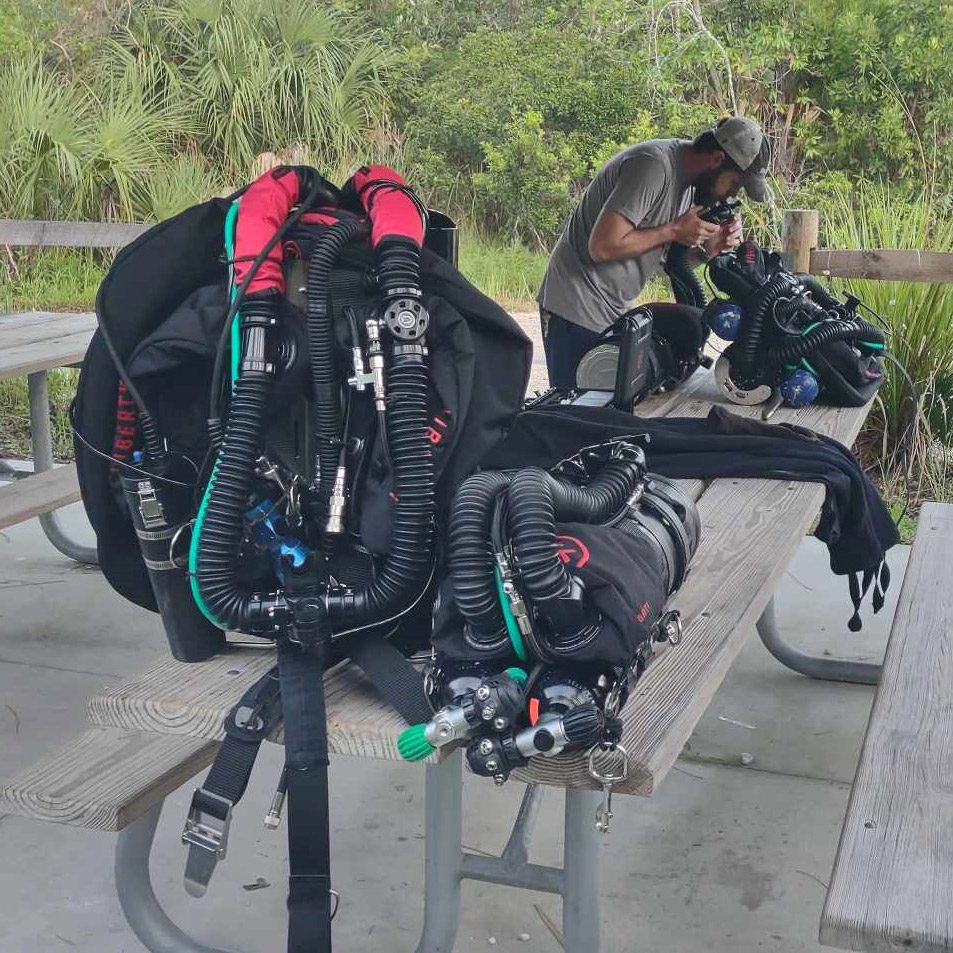
The Journey to BOB
Matt and I both dabbled with BOBs prior to getting more heavily committed three years ago. The reasons we looked at BOBs are not unique: depth, duration, distance, and volatile cave conditions are the top four. Around the time I started decidedly down the path of BOBs, I met Joe at Divesoft and was introduced to their Sidemount (SM) Liberty (2019). At that time, I was using a cobbled-together Satori unit that had been modified to mCCR with cells to monitor the breathing loop. Super basic, very robust, and quite affordable—yet I quickly outgrew and dismissed it as a viable option due to unit support and the amount of modification required making it less reliable.
Several KUR members were provided a familiarization of the Halcyon RB80 sidemount unit, and some still use it as their preferred BOB. Rugged to near bullet-proof, the RB80 is a PSCR/gas extender and offers requirements in gas mixes and availability that, for some, made it an option but not the option. Matt had been using a KISS Sidewinder mounted to the harness under his backmount Megalodon (MEG) for several years. The work of breathing, balance, and streamlining is fantastic and has been utilized on some long penetration dives. The Sidewinder/MEG combo is simple, robust, and relatively streamlined for its capability. But it is heavy out of the water, must be dressed into, and doesn’t allow for removing components for transport, passing restrictions, or sharing in a team scenario.
The SM Liberty seemed an intriguing alternative as a BOB and a stark contrast to the Fathom mCCR needle valve unit I was using as a primary backmount rebreather at that time. The Liberty was different in that its electronic capabilities are incredibly advanced, and it adds solenoids for automated oxygen delivery coupled with DSV mounted manual add valves. A key feature of the Liberty as a BOB is its Bailout (BO) mode, which provides an advantage in allowing it to be programmed as a stand-alone/divorced handset that calculates deco based on a programmed PO2 that matches the primary unit and ignores the loop PO2. That PO2 can be easily changed for descent, bottom, and deco segments of the dive. The electronics ignore the loop PO2 until it falls below the FO2 of your bailout gas, then it will deliver oxygen to return the loop PO2 up to the FO2 of the gas, thus never allowing the unit to be used without delivering oxygen to the diver.
It is important that BOB loops be managed in both volume and breathability. The reasonable size of the SM Liberty counter lung means it is easy to manage those loop parameters. It also limits the buoyancy shift as you move throughout the dive profile. I was attracted to the fact that the Liberty can “detect” when the loop is in use, and it will automatically revert to an eCCR and begin injecting oxygen to keep the loop breathable until the diver can change the mode.
Another convenient feature of the SM Liberty is its form factor—it’s essentially equal in size to our normal LP 120 side mounted bailout cylinder. With my commitment to work with the Liberty as a BOB, we moved through the certification process. With that done, we started to gain experience with the unit throughout 2021 and 2022. Using it on dives in different systems and across profiles ranging from a standard wreck dive to a 12-plus-hour dive in over 122 m/400 ft of water and 2,438 m/8,000 ft of linear penetration helped to show its value.
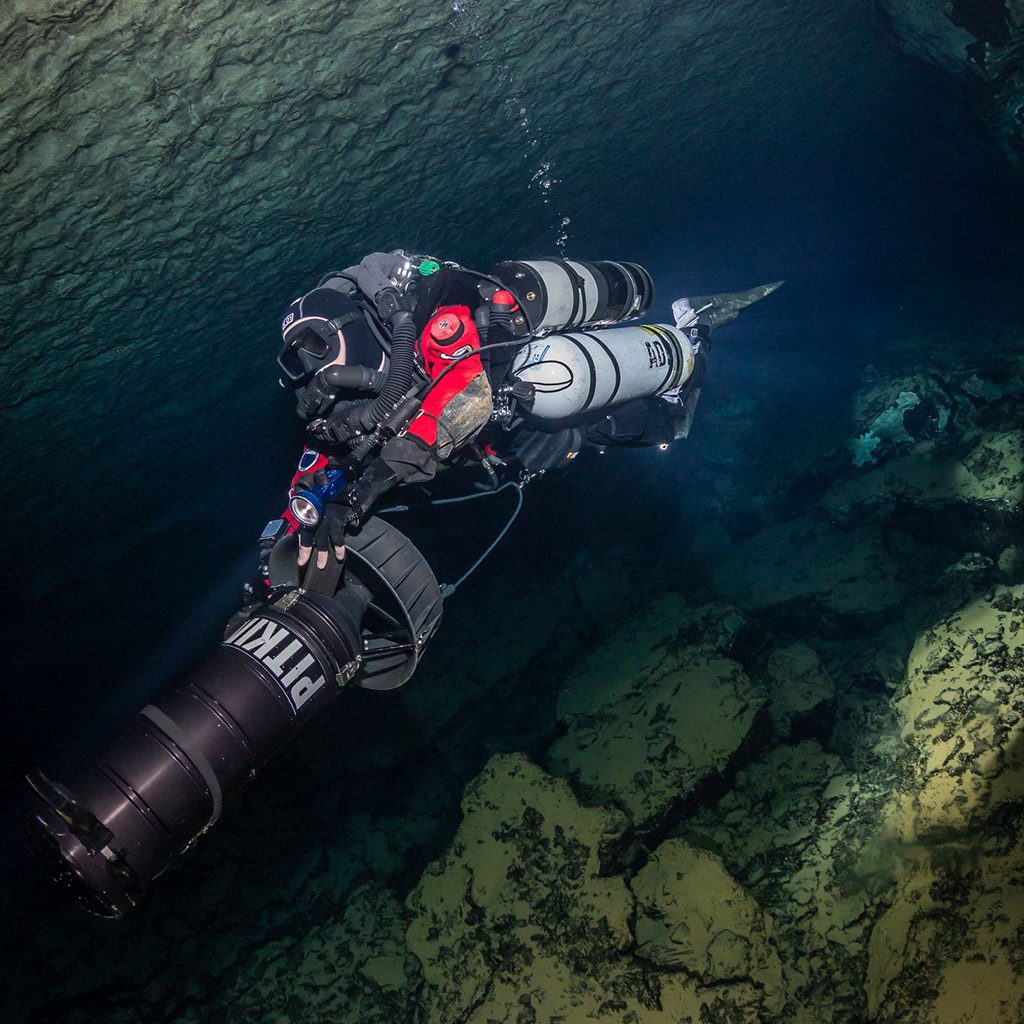
Give Me Liberty and Give Me Depth
Now a look at 2023. Matt and I each purchased a BM Liberty and a SM Liberty and moved full force into the use of the units as primary and secondary rebreathers. We felt it was advisable to use one operating system for maximum comfort when utilizing a BOB. This year netted 31 dives using a BOB in challenging and unique situations—because becoming great requires practice. For example, in one cave system, depth fluctuates from zero to 15 m/50 ft five times over a linear distance of 1,676 m/5,500 ft. Never mind the other significant changes—that profile teaches you things.
Mill Creek Sink also has some famous ups and downs, and navigating those provided even more repetitions to hone our buoyancy skill. Mill Creek Sink, Eagles Nest, School Sink, Ginnie Springs, Manatee Springs, and Peacock 3 gave us the opportunity to test the units on dives from three hours to 11 hours long with various penetrations up to 8,000 linear feet. An abbreviated season at Weeki Wachee was made more productive by utilizing BOBs and providing documentation of some beautiful sections of the cave. We explored a new passage at Werner Boyce Salt Springs using a Fathom Gemini and a SM Liberty. We will continue gaining practice and refining our process using a BOB in 2024 and beyond.
These dives yielded a few key takeaways. First, other than operator errors, the units performed without fault. The sliding shut-off on the ADV needed to be removed, or secured open, since it could be bumped closed to a catastrophic result. A fitting was created by Divesoft that simplified hose routing and allowed off-board diluent use that could be the same or different from the primary unit. We had to get happy dropping from two LP 120 bailout cylinders to just one worn on the left side. This move streamlined the package and made sense for simplification. The biggest issue I found using two cylinders and the BOB was that the kit was like towing a sail. Drag was up and speed was down. While it was not a deal-breaker, we found that the SM Liberty—when attached below a sidemount cylinder—made it more exposed to cave contact, was not as easy breathing, and gave us too much clutter to reach around while exploring and manipulating gear. So, gone was a 120.
The next problem was to correct the imbalance of the unit on the right and the cylinder on the left. Simple fix: weigh them in water and add the appropriate lead. This balanced our attitude in the water and provided the ballast that was needed for easy deco lounging. Next item on the “learn and overcome” list was that dual units add more gas space and another loop PO2 to manage as well as computers to monitor. We use the BOBs on nearly all dives to condition ourselves and build muscle memory. It’s amazing how quickly we were able to make the move to managing it all as second nature.
I have found using the BOB loop as a fourth gas space simplifies some things when you have sawtooth profiles in that you can manage the two loops and navigate certain changes in depth—no need to dump the suit or wing when the fluctuations are planned well. Admittedly, getting in the water with two units takes a few minutes longer but not annoyingly so. The SM BOB clips on just like a stage with a valve bungee, and the only additional bits are a computer to stow, a QC-6 to connect, and a DSV to clip on the left shoulder. In total, these adjustments are fair when balanced against the capacity of a BOB to bring you home.
This list is not complete: it will grow, and some things were eliminated here due to space vs. importance.
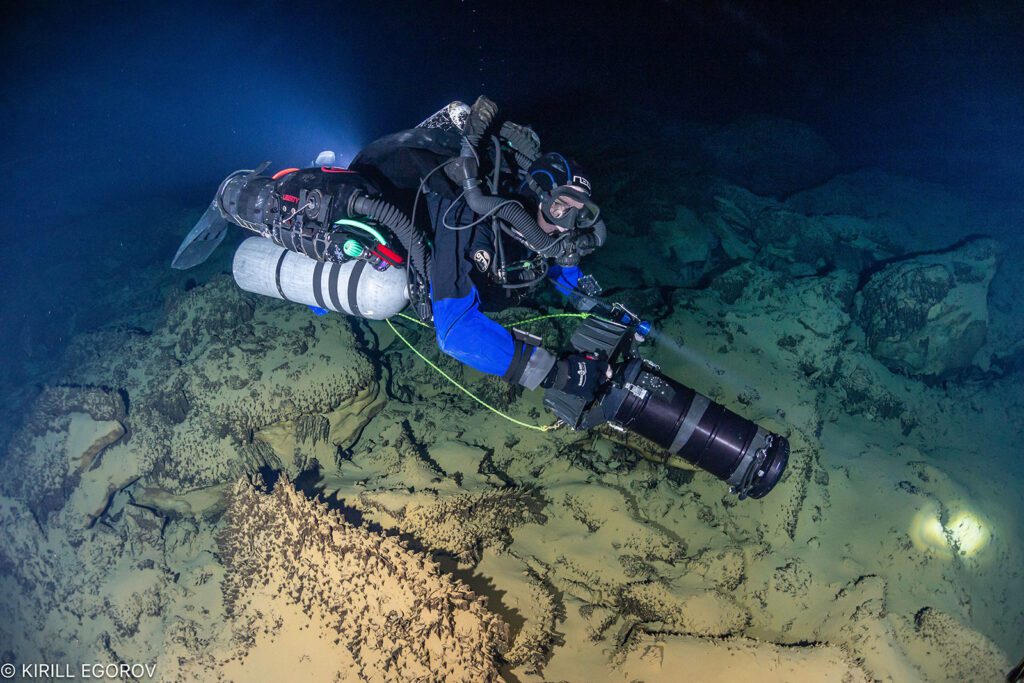
A Keeper vs. Team BOB
Configuration refined, drag reduced, and listing addressed, it was time to tackle the two types of BOBs that exist (not that all would agree): The one you keep (Keeper) and the one the team may utilize. The former is far more common for us. The Keeper is plumbed into the offboard diluent supply via QC-6. The onboard 2L is filled with an appropriate dil but remains turned off, unless needed. The Keeper is largely used when other members of the team have a BOB as well. Make no mistake, a Keeper is my unit and calculated in my BO planning and therefore critical to my dive. I cannot simply give it away and be reassured with the knowledge that I have enough gas given an issue of my own. Once it’s gone, I probably won’t get it back.
Quick gut check on gas planning: I dive thirds. OC, CCR, and BO CCR are all the same foundation. It’s a lot of gas—but it makes me feel warm and fuzzy. For OC, this is what is taught in OC technical and cave diving courses. In CCR, the CCR is a third and my BO gas is two-thirds. For a BOB with CCR dives, each CCR is a third and then one-third sanity gas in OC. Other divers employ different strategies. I have a friend who is an amazing diver that uses two SM rebreathers and nearly no OC gas. He is fully committed; I am not. To each his own, and I’ll dive with that guy anywhere.
Back to the topic: the Keeper is My Precious whereas the team resource BOB is different. In a team use plan, the cave is generally set up with safeties adequate to exit, and the BOB adds a layer of safety and margin of gas to simplify the exit. We could exit on the OC gas available, but then there are a lot of things that would change, and the cave would then need to be reset for future exploration dives. Enter the Team BOB. The unit is set up similar to the Keeper with onboard dil and plumbed into my off-board supply for the dive up until it is needed. Then the QC-6 is disconnected from me, the on board dil turned on, and presto: instant standalone breather to donate.
Complexity of the unit, processes, and configuration must be considered in this writeup and in our choices. A second rebreather adds what can be a dangerous level of task management and the potential for overload. After all, it’s not usually one thing that kills you—it is the compounding of problems—and using two rebreathers is a significant compounding. Complexity or task overload is a risk management assessment that must be done on a personal and team level with input from trusted sources that will be your devil’s advocates. No confirmation bias or echo chambers should be tolerated: seek good feedback.

If the BOB Fits Wear It
What feels to me to be a fair tradeoff of variables when using a BOB cannot be transferred to other individuals. Our normal dives over a given year are probably not anything near normal. Managing no less than three stages and as many as five with backup scooters at depths in excess of 90 m/300 ft on dives of over six hours average is our norm—for many years. Application of our techniques to your decision tree is a poor starting position. You must address your basic skills first. None of this “helium is expensive,” “it’s better to use rebreathers,” “technology is so much better” bases to start your analysis of BOBs. If you can’t do it with the OC equipment you need, safely, then you cannot do it with a BOB. There is a real risk when adding a BOB to your quiver. Be honest with yourself.
All this having been said, we can bring it back to where we started: The BOB in various forms has made a place on our gear shelves as a viable option to complete the dives we do. We have learned a few things with much more to come. We have worked to build processes and systems and then practiced these in drills and real-world scenarios. We have included BOBs in nearly all our dives in 2023 for myelination purposes and task management proficiency. We intend to stay focused and vigilant on gaining and maintaining the necessary level of skill critical to creating second nature diagnosis of in water issues that only unit familiarity can provide.
You can follow all of us using various units in our research and scientific diving on our Facebook Page: Karst Underwater Research. The website is: Karst Underwater Research.
DIVE DEEPER
InDEPTH: When Easy Doesn’t Do It: Dual Rebreathers in Extended-Range Cave Diving by Tim Blömeke
aquaCORPS N12: Designing a Redundant Life Support System by William C. Stone (1995)
InDEPTH: Exploration of Weeki Wachee 2019-20: The Search for The Source Continues by Charlie Roberson.
Alert Diver: Where Mermaids Fear to Tread by Michael Menduno
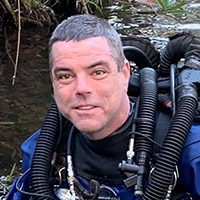
Bob Beckner has been diving for 36 years and technical diving for 27. Growing up in Florida led him to cave diving and wreck diving and working in several dive shops along the way. He was fortunate enough to have had Terrence Tysall as a technical instructor and learn in a very “GUE” like fashion before GUE existed. He participated in several USSR Monitor expeditions with the Cambrian foundation, gone with Mote to the Gulf Blue Holes, and worked with Karst Underwater Research for 13 years helping explore and document Florida’s karst features. His number one bucket list dive type: mine diving.
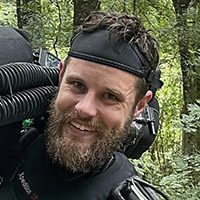
Matt Vinzant has been technical diving for 24 years. Matt grew up in central Florida and worked in the scuba industry for a decade. Matt has been actively exploring submerged and dry caves in the western hemisphere with Karst Underwater Research, Karst Terrain Explores, The US Deep Caving Team, and Beyond the Sump. Matt is currently the Executive Director of Karst Underwater Research based out of Florida.






















































